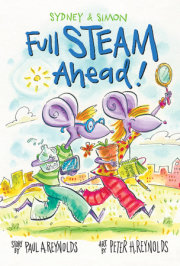Twin mice solve a problem using STEAM — science, technology, engineering, arts and mathematics — in this series opener.
When a heat wave threatens to kill the window-box flowers the twins need for their much-anticipated Art in Bloom show, they have to both figure out why their third-story window won't open (the water cycle is to blame) and how to get water to the thirsty flowers (an invention of Archimedes' is the answer). Luckily, several dei ex machina lead the twins to some people who can help them spark some ideas. Sydney and Simon, the offspring of an inventor mother and poet father, are steeped in the arts and sciences that will help them in "thinkering" about their problem and finding a solution. Sydney expresses herself through drawing, using her spiral-bound Wonder Journal to jot down ideas, record hypotheses and draw what she observes. Simon's Wonder Journal is on a tablet, allowing him to take pictures, record video and sound, and combine all these into something new. Sydney and Simon are solid, though perhaps idealized, models for those aspiring to STEAM careers — though in this chapter book, readers accustomed to STEM programs will be struck by the emphasis on the arts piece. (STEM to STEAM is a Rhode Island School of Design inititave to add the arts and design to STEM). Ink-and-watercolor-wash illustrations complement the text.
Inspiration for young scientists, artists and inventors.
—Kirkus Reviews
Twins Sydney and Simon are the best kind of inquisitive; they're eager and excited to investigate all the wonders that come their way. When their windowbox flowers are threatened by a stuck window, the two get to work exploring how to solve their problem. As they seek the input of trusted adults and creatively hypothesize how to get water to their flowers before they die, they end up incorporating elements of science, technology, engineering, arts, and math (STEAM) into their efforts. The book's overall message-that life is full of opportunities to solve problems, learn, and be creative-could easily feel contrived, but Reynolds weave these elements into an appealing narrative. All concepts are concisely explained through the text and accompanying illustrations of the purple mice at work, with a helpful glossary of terms at the end. Many a young artist, inventor, and idea enthusiast will find plenty to enjoy in this early chapter book.
—Schooll Library Journal







